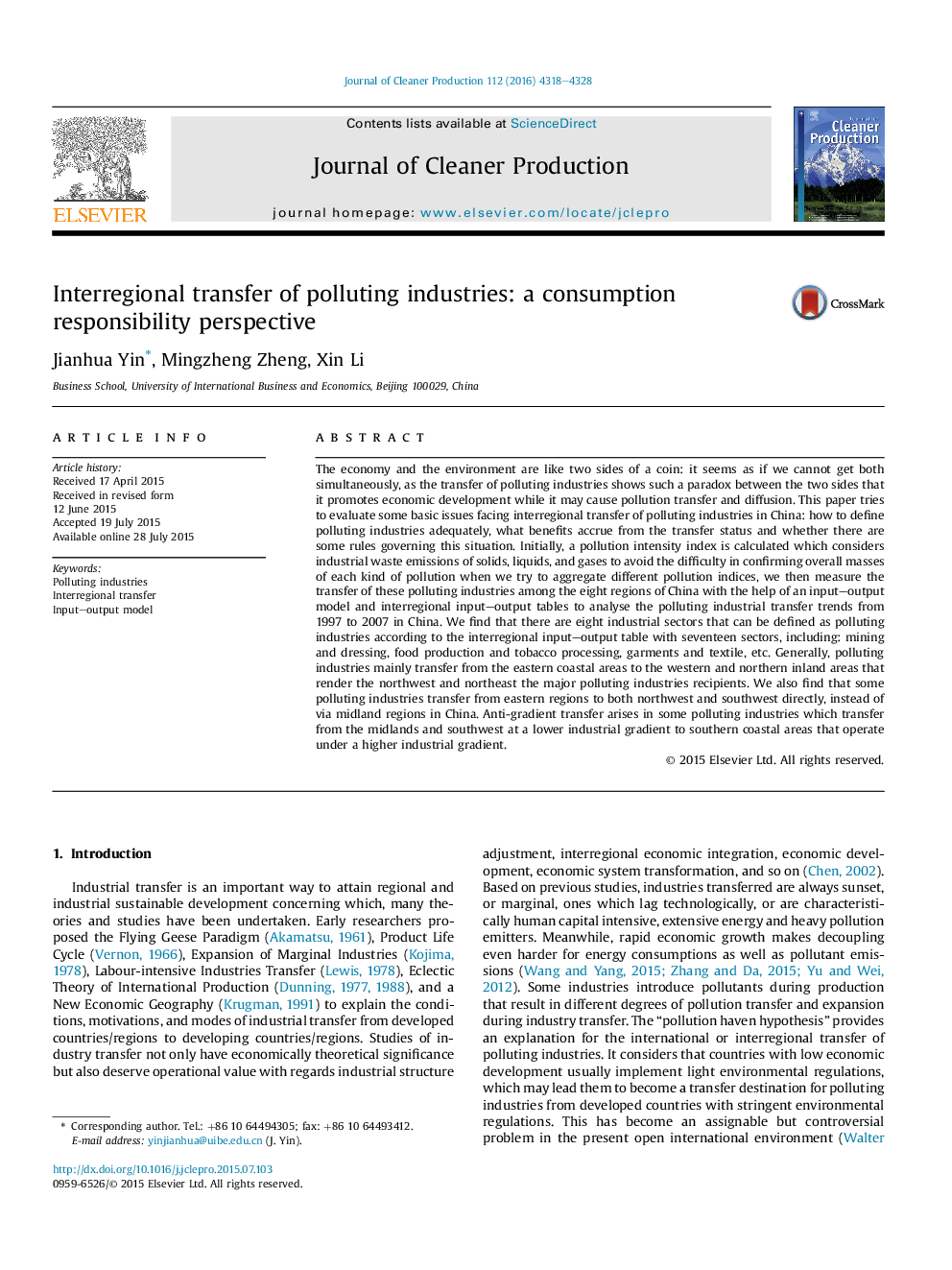| کد مقاله | کد نشریه | سال انتشار | مقاله انگلیسی | نسخه تمام متن |
|---|---|---|---|---|
| 10687974 | 1017969 | 2016 | 11 صفحه PDF | دانلود رایگان |
عنوان انگلیسی مقاله ISI
Interregional transfer of polluting industries: a consumption responsibility perspective
ترجمه فارسی عنوان
انتقال بین مناطق صنعتی صنایع آلاینده: دیدگاه مسئولیت مصرف
دانلود مقاله + سفارش ترجمه
دانلود مقاله ISI انگلیسی
رایگان برای ایرانیان
کلمات کلیدی
صنایع آلاینده، انتقال بین منطقه ای، مدل خروجی ورودی،
ترجمه چکیده
اقتصاد و محیط زیست مانند دو طرف یک سکه هستند: به نظر می رسد که ما نمی توانیم هر دو را به طور همزمان دریافت کنیم، زیرا انتقال صنایع آلاینده چنین پارادوکس بین دو طرف را نشان می دهد که توسعه اقتصادی را ترویج می دهد در حالی که ممکن است باعث انتقال و انتشار آلودگی شود . در این مقاله سعی شده است تا برخی از مسائل اساسی روابط انتقال بین صنایع آلاینده در چین را بررسی کنیم: چگونگی تعریف صنایع آلاینده به میزان کافی، اینکه چه مزایایی از وضعیت انتقال و چه قوانینی برای این وضعیت وجود دارد. در ابتدا یک شاخص شدت آلودگی محاسبه می شود که در آن اکسایش مواد زائد جامدات، مایعات و گاز ها را در نظر می گیرد تا از تأیید توده های کلی هر نوع آلودگی جلوگیری کند، در حالی که سعی می کنیم شاخص های آلودگی مختلف را جمع کنیم، صنایع در میان هشت منطقه از چین با کمک یک مدل ورودی-خروجی و جداول ورودی / خروجی بین منطقه ای برای تحلیل روند انتقال آلودگی صنعتی در سال های 1997 تا 2007 در چین. ما دریافتیم که هشت بخش صنعتی وجود دارد که می تواند به عنوان صنایع آلاینده با توجه به جدول ورودی / خروجی بین منطقه ای با 17 بخش از جمله: معدن و پانسمان، تولید مواد غذایی و فرآورده های دخانی، پوشاک و نساجی و غیره تعریف شود. به طور کلی صنایع آلاینده عمدتا انتقال از مناطق ساحلی شرقی به مناطق غربی و شمال غربی که شمال غربی و شمال شرقی را دریافت کنندگان صنایع عمده آلاینده می کنند. ما همچنین می بینیم که برخی از صنایع آلودگی به طور مستقیم از مناطق شرقی به مناطق شمال غربی و جنوب غربی به طور مستقیم از طریق مناطق میدانی در چین انتقال می یابند. انتقال ضد گرادیان در برخی از صنایع آلودگی رخ می دهد که از میدلند و جنوب غربی از یک شیب صنعتی پایین تر به مناطق ساحلی جنوبی که تحت یک شیب صنعتی کار می کنند، انتقال می یابد.
موضوعات مرتبط
مهندسی و علوم پایه
مهندسی انرژی
انرژی های تجدید پذیر، توسعه پایدار و محیط زیست
چکیده انگلیسی
The economy and the environment are like two sides of a coin: it seems as if we cannot get both simultaneously, as the transfer of polluting industries shows such a paradox between the two sides that it promotes economic development while it may cause pollution transfer and diffusion. This paper tries to evaluate some basic issues facing interregional transfer of polluting industries in China: how to define polluting industries adequately, what benefits accrue from the transfer status and whether there are some rules governing this situation. Initially, a pollution intensity index is calculated which considers industrial waste emissions of solids, liquids, and gases to avoid the difficulty in confirming overall masses of each kind of pollution when we try to aggregate different pollution indices, we then measure the transfer of these polluting industries among the eight regions of China with the help of an input-output model and interregional input-output tables to analyse the polluting industrial transfer trends from 1997 to 2007 in China. We find that there are eight industrial sectors that can be defined as polluting industries according to the interregional input-output table with seventeen sectors, including: mining and dressing, food production and tobacco processing, garments and textile, etc. Generally, polluting industries mainly transfer from the eastern coastal areas to the western and northern inland areas that render the northwest and northeast the major polluting industries recipients. We also find that some polluting industries transfer from eastern regions to both northwest and southwest directly, instead of via midland regions in China. Anti-gradient transfer arises in some polluting industries which transfer from the midlands and southwest at a lower industrial gradient to southern coastal areas that operate under a higher industrial gradient.
ناشر
Database: Elsevier - ScienceDirect (ساینس دایرکت)
Journal: Journal of Cleaner Production - Volume 112, Part 5, 20 January 2016, Pages 4318-4328
Journal: Journal of Cleaner Production - Volume 112, Part 5, 20 January 2016, Pages 4318-4328
نویسندگان
Jianhua Yin, Mingzheng Zheng, Xin Li,
